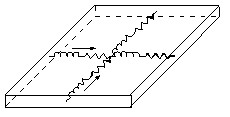Bidirectional Conductor: about
Definition
A Bidirectional Conductor is a planar (2D) conductor :
- sufficiently thin so we can omit the current variation on the thickness of the conductor
- for which it is not easy to make an initial assumption on the path of the current flow
Creation
A Bidirectional Conductor is created in a direct way. Its geometry is made with the standard tools for geometry building (points, lines, faces, volumes).
Coherency
The plane of electric current flow is identified by means of a face.
Volumes characterizing the bidirectional conductor must have the same thickness with respect to a given direction. And they must have lateral surfaces (or portions of these surfaces) that are next to each other.
Lateral surfaces are volume surfaces perpendicular to the face identifying the plane of electric current flow.
2D meshing
In case of a 2D mesh it is the plane of current flow that is discretized and not the depth of the conductor.
The conductor is split up into plane elements in which two privileged directions of current flow are considered.
In each of the four partial electric circuits associated to a plane element the current density is assumed to be uniform.


Terminals
The terminals associated to a bidirectional conductor are created after the creation of the conductor.